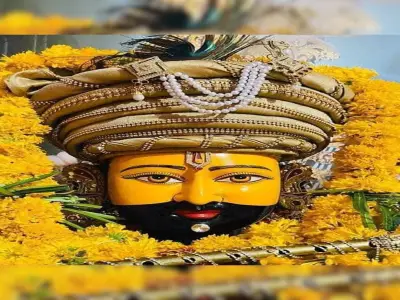Who is Khatushyamji
Khatushyamji, also known as Shyam Baba, is a widely revered deity in India, worshipped primarily in the northern states, especially Rajasthan. He is believed to be an incarnation of Barbarika, the grandson of Bhima, one of the Pandavas from the epic Mahabharata. Khatushyamji’s story is rooted in devotion, sacrifice, and divine blessings, and he is regarded as the “God of Kali Yuga” (the present age), believed to help those who worship him with true devotion.
The Legend of Khatushyamji
Khatushyamji, originally Barbarika, was the son of Ghatotkacha (Bhima’s son) and Maurvi (the daughter of the demon Muru). Barbarika was a mighty warrior blessed with three divine arrows, gifted to him by Lord Shiva, making him almost invincible. Due to his possession of these powerful arrows, he became known as Teen Baan Dhaari, or the bearer of three arrows.
Before the great Kurukshetra war, Barbarika vowed to fight on behalf of the weaker side. His vow put him in a dilemma, as the balance of power in the war would keep shifting. Lord Krishna, understanding the implications of his vow, tested Barbarika’s abilities and ultimately asked him for the supreme sacrifice—to give up his head. Barbarika, a true devotee of Krishna, agreed to the sacrifice for the greater good.
Before his sacrifice, Barbarika requested the boon of watching the battle of Kurukshetra, which Krishna granted by placing his severed head on a hill, allowing him to witness the war. After the battle, Krishna blessed Barbarika, declaring that in Kali Yuga, he would be worshipped as Shyam or Shyam Baba, and that those who pray to him with a sincere heart would have their wishes fulfilled.
The Khatushyamji Temple
According to legend, after the Mahabharata period, Barbarika’s head was submerged in the river Rupavati. It was later discovered in the village of Khatu in the Sikar district of Rajasthan, when a cow began offering its milk at a particular spot daily. Upon excavation, the head was found, and a temple was built in Khatu to honor him. This temple is now one of the most popular pilgrimage sites in Rajasthan.
Worship and Significance
Khatushyamji is worshipped for his compassion and ability to grant wishes. He is seen as a deity who protects devotees and helps them overcome hardships. People from all walks of life visit the Khatushyamji Temple to seek blessings, and the temple attracts massive crowds, especially during festivals like Phalguna Mela, held in February/March.
Devotees often chant, “Hare Ka Sahara, Shyam Hamara” (Shyam is our savior), reflecting their deep faith in him. Khatushyamji symbolizes selfless devotion, sacrifice, and righteousness, and he is widely venerated across India as a god who listens to the prayers of his devotees and guides them through difficult times.
In essence, Khatushyamji is revered as a compassionate, miracle-working deity who embodies divine power and devotion, continuing to inspire millions of followers to this day.

